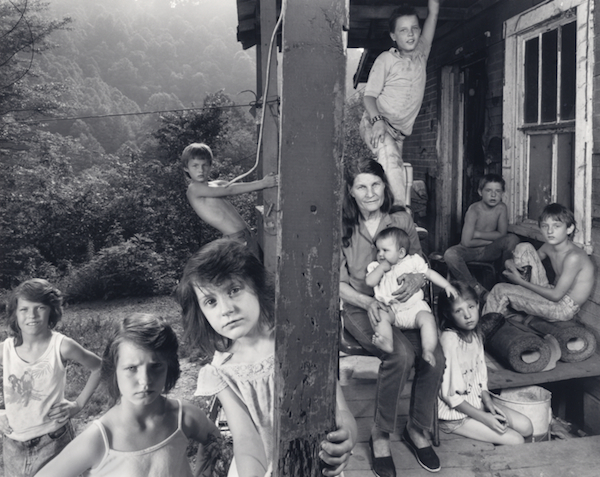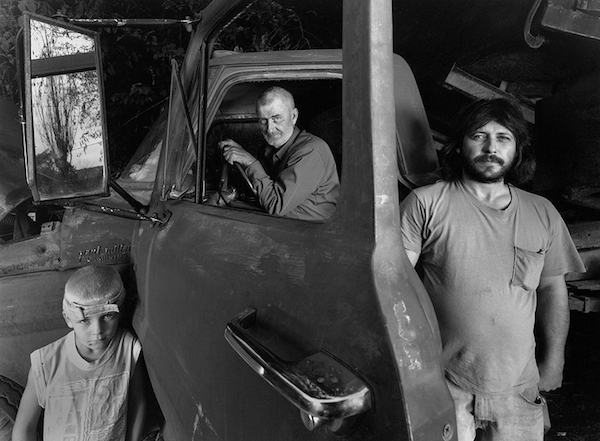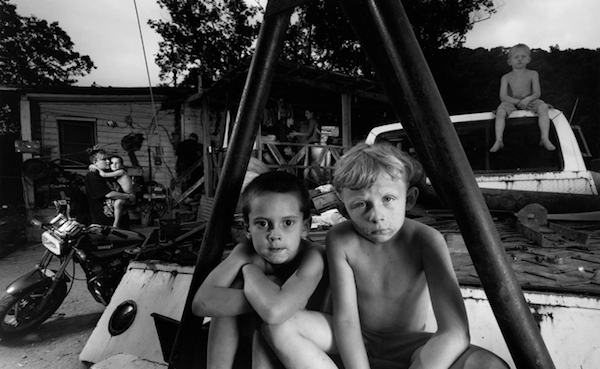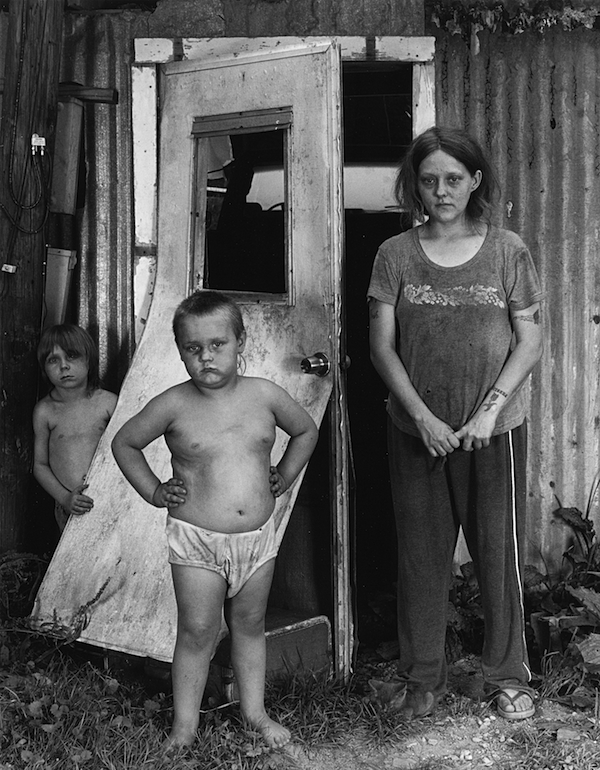 The next photographer featured in the series Looking at Appalachia is Shelby Lee Adams. Shelby contacted me via Facebook last month and was kind enough to agree to collaborate on this series. After nearly three hours of phone calls and many email exchanges, he wrote the following essay, published here for the first time.
The next photographer featured in the series Looking at Appalachia is Shelby Lee Adams. Shelby contacted me via Facebook last month and was kind enough to agree to collaborate on this series. After nearly three hours of phone calls and many email exchanges, he wrote the following essay, published here for the first time.
Shelby Lee Adams' photography has been published in four monographs - Appalachian Portraits (1993), Appalachian Legacy (1998), Appalachian Lives (2003), and Salt & Truth (2011). He has received numerous grants and awards, most recently a Guggenheim Fellowship in 2010.
The Work of Looking
I was born and raised in a holler in Eastern Kentucky, lived and grew up in the middle part of Johnson’s Fork, in Letcher County, Kentucky. My families, on both sides, were farmers. One grandpa was also a timber man and the other a teacher. Neither of my grandfathers worked in the mines, but we knew many miners and discussed their lives and working conditions. Two of my uncles were doctors - one became disabled after serving throughout World War II. I became a part time unofficial medical assistant to the other uncle when he went into the hollers making house calls. My uncle Doc Lundy was a great resource and introduction. The mountain people loved him; he greatly appreciated their openness, sense of humor and generosity of spirit. We’d go out and visit, riding in his Willis Jeep. He loved the people and I think that transferred over to me. He was sort of my childhood mentor and helped introduce me to the mountain culture. Perhaps the earthiest and richest cultural view is in the hollows. My father and others didn’t see the culture the way my uncle did, so there was always this difference in my own family. It may explain why I photograph the way I do, in a direct, straightforward manner, working with a cumbersome view camera, expressing some tensions and divisions within the photographic compositions.
I think of my work as an insider’s view even though I now live in Massachusetts, making long-term return visits. Similar to how I grew up traveling with my parents, going back and forth with my father’s many jobs, but always returning to Johnson’s Fork. When your blood’s connected, and you're born and raised in a place, you’re always connected. My work is all done by personal introductions. I’ve never worked through agencies like VISTA, the Peace Corps, or government welfare offices; always by personal introductions and word of mouth. That’s how I’ve worked for close to 40 years now. I say that with pride.
In 1964, President Lyndon Johnson's War on Poverty was in the news; it was a big deal in our region. LOOK, LIFE, The Saturday Evening Post, and Charles Kuralt’s, famous program, “On the Road,” among others were all doing work and stories in different parts of Appalachia. I attended high school from 1964 through 1968. My uncle would call from his office with inquires he received from the media requesting introductions and I would gladly show people around after school. They told us when we first together we would all receive pictures within a month or two, further, adding how proud they were to be with us.
I soon regretted sharing our rural life with some photojournalists. When I read and saw examples of the essays done, I felt betrayed. They wrote degrading descriptions about our people and homes. For example, a home was referred to as "a run down, rotting shack." It may have been different from a city brick home, but it still was someone’s home with children inside to consider. This could have been described as a modest dwelling in need of repair. Some were described as broken and poor. If asked, someone might describe themselves as, “one of God’s children, rich in spirit.” It seemed little consideration was given to the people’s feelings or the deeper life they actually lived and certainly the culture was considered and seen only one way – poor.
We never received any pictures from the photographers. We were mailed publications later, second hand magazines, sent to us by a church group from Chicago. That sense of betrayal affected the entire region, not just me. It was an embarrassment to all and still troubles and affects many today.

Everyone assumes I was born a photographer. I was an art student attending Whitesburg High School, receiving the schools annual art award in 1968 (the year I graduated). I was always drawing and painting, mostly from nature. I knew a little about photography. I owned a 35mm camera and later attended the Cleveland Institute of Art. I took my first photography class my second year of art school at age 19. My teacher, Ralph Marshall, was a great man, an inspiring teacher. He grew up in England in a coal-mining town near Wales. He saw promise in my first Appalachian pictures that I didn’t recognize. He encouraged me after viewing my first photographs made back home. He made me feel that I was doing something special right away. It was his interest and the excitement of the medium itself that caused me to change majors from painting to photography.
Artists, not photographers, inspired my beginning search for creative growth. Goya, el Greco, (Francis) Bacon, Van Gogh, Rembrandt, and Corot, among others – they motivated my artistic pursuits more than photographers. I’m 61 years old now. I can look back at those same paintings and see how they nurtured and inspired my development when I was young. Timeless, creative work keeps inspiring and communicating from generation to generation. Just as specific mountain people were, and are, inspired sages to many of us, their photographs reflect iconic and everlasting. Painting has always been more stimulating to my photography’s development along with writing and reading great literature. I didn’t trust the practitioners of photography so much because of my experiences with the War on Poverty photographers. I came back to my roots visually through appreciating the passion, spirit, discipline, and dedication that artists and paintings could stir within me.
I’m not a documentarian per se. My work is autobiographical, people-oriented, personal and subjective, with humanistic and artistic concerns. I’ve never said I was a documentary photographer. I’m careful not to. When I teach workshops at the International Center of Photography, among other places across the country, I teach environmental portrait photography and lighting. Still I’m often written about as a documentary photographer and that approach itself has fortunately changed to be more open, individualized, and creatively more all-encompassing. Those changes in photography have happened during my career.
I am continually searching through my own roots. I love reading Southern literature. Faulkner, he got the dialect. He loved, and was, the culture. I’ve never veered from that. When home, what I do is visit, sit and talk for hours with people. I’m genuinely interested in what’s going on in people’s lives. We catch up. Some don’t understand that I have real relationships with diverse people. I try to be as personable as possible. The people are genuine and that’s what feeds a relationship; honest back and forth sharing with vulnerability. We build understandings together. When away, I keep in touch with people, mailing photos and cards, mostly talking by phone.

When looking at photographs - and this is part of my training as an artist - I realize people see, process, and react to what is in their mind's eye with some parts remaining unconscious, not totally responding to what is in front of their physical eyes, as much the mind's eye. This is true of photographer’s perceptions when working as well. We attach ourselves, bringing forth our own, often times, unresolved issues and react to the emotions and thoughts the photograph or situation evokes and brings forth in us individually, not necessarily at all what is reflected in the content of the photograph, or the life, or situation actually before us. The viewer, presenter, and subject are all participants in what I call, “The Work of Looking.”
Our ancestral mountain people are mythologized into our greater existence from our beginnings, a part of our childhood and permanent memories. If we are truly honest with ourselves, we know this cannot be erased. If you are from these mountains, your and my dreams and reality itself are engraved within this collective group consciousness forever. One can choose to repress, but sooner or later, the lives and images of our mountain people will return to us and keep returning until we come to terms with their importance, not just the ones we chose, but all.
“We all are the same, we need to really look at this situation right here. We really need to look at life. We are a blessed people because we're able to walk and able to talk, we have the freedom to get out and to work and raise our families and we ought to treat each other equally.” - Philip Zambala, friend and subject of Shelby Lee Adams
One reason I have continued to work as I do, using a formal view camera, Polaroids and lighting, is because of the complexity of this culture. You can have a descriptive photojournalistic documentary image, culturally enriching authentic mountaineer and a socially conscious politically charged picture, all represented in one picture, in one moment here. In essence, my work is about all those things and more with my own autobiographical and psychological pursuits expressed as well. Pictures can get complicated and share multiple purposes, yet remain separate - personal and meaningful to each of us.
In Eastern Kentucky today, we have vast problems with low self-esteem, both youth and adult, resulting in epidemic drug and alcohol abuse, suicides, and crime, causing many premature deaths. Too many of my own relatives, friends, and their children have died or been permanently damaged from this kind of predominately drug-related activity. I cannot help but believe that in our homes and schools, if we really recognized all equally, with total mutuality and solid support, our children today might not be so vulnerable to this ongoing travesty. Some country preachers testify and preach that in Appalachia we have greatly admirable traditional family values and at the same time, are known as a judgmental society. “Love your neighbor as yourself,” our preachers remind us.

What can an individual do? What I have done is gone into the heads of many hollers, without much of an introduction, not knowing if I would be accepted or shot at and still I’ve kept going. To look into the eye and shake hands with whomever I met, telling them I needed to photograph them because they were important and maybe their kind might be dying out. Some laughed and others said I was crazy, but they all invited me in to sit down and talk. I’d tell them my dream of photographing all the holler dwellers in Eastern Kentucky with dignity and respect. That is what I’ve tried to do and those people have not complained and that makes me feel worth something.
When you study a painting or a great work of art, it can be a spiritual exercise. You come back to it again and again, changing yourself as your perceptions change and mature. From my formal portraits made in the heads of the hollers, I want a direct, somewhat raw engagement where you and the subject are looking into seeing itself, discovering each other together on an unparalleled and equal course of discovery to create a flowing communicative relationship between the viewer and the subject. You are mirroring and they are mirroring humanity, one to another, humbly and heart felt, dropping guardedness. Sometimes some disturbing effects come forward, but they need to be confronted and perhaps cannot be seen in any other way. Together, through looking, we can become more genuine and carry that into real life relationships that bond and unite. But some of us don’t seem to want to see or experience the real other people, yet we all are in the same community.
For those who are interested, having the will to come forward and desiring to transform themselves by participating in engagement with photographs serving as a catalyst, one can break down the stereotype. You must keep coming back to do the work of “looking.” Through familiarity, prayer, and study, our weaknesses and fears bleed away, slowly clarifying as fresh mountain water clears after a slow rain. Humanity comes forward revealing itself and the stereotypes slowly disappear. We then overcome our uncertainties surrounding our culture and people, embracing a more total humanity, not excluding or hiding those in the shadows needing our help. That’s what real engagement is for me. That’s what I’m about - my work and this serious pursuit. That is what genuine art and serious photography has always been for me.

When embracing all of humanity, there is no elitism or poverty. If people in the hollers can do this, so can you, each in your own way. Photography is a powerful tool and I am one Kentuckian who is concerned about many of our people that some wish weren’t here. I know my process is now reaching others. Maybe only a few, one at a time. For some, it's a difficult cathartic experience, but a life-changing and affirming spiritual journey. To the people photographed and seen, maybe with real mature recognition for the first time, they are my purpose. They make it all worthwhile. My work in Appalachia is a labor of love. It’s not about money.
As a college professor, I’d tell my students, “If you photograph someone, you owe them a picture. That’s an obligation. That’s a good thing, a beginning to clear communication.” More people are appreciating my work today, some from far away, some at home. Maybe because they are freeing themselves and shedding the skin of petty cultural complexity, seeing more clearly, humanity just needing humanity.
Shelby Lee Adams
August 31, 2012
All photographs and essay "The Work of Looking" © Shelby Lee Adams.
1. Leddie and Children, 1990.
2. Brenda, 2004.
3. Angela, 2006.
4. Freddie's Place, 2004.
5. Pauline Standing, 1979.




















